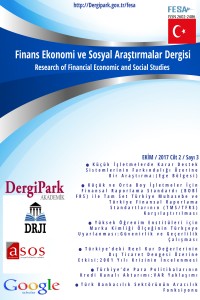THE EFFECT OF REAL CURRENCY VALUES IN TURKEY ON EXTERNAL TRADE BALANCE: AN INVESTIGATION OF THE 2001 ECONOMİC CRİSES
Öz
After the 1980s, a lot emerging economies implemented the
outward-oriented growth model. External trade balance was the most important
growth variable for the outward-oriented growth model. So, the real currency
values have important role for the model’s success. In this context, in this
paper, I search the effect of the 2001 economic crisis on the external trade
value of real currencies has been investigated.
Anahtar Kelimeler
Emerging Economies Currency Values External Trade Balance The Outward-Oriented Growth Model
Kaynakça
- Akbostanci, Elif, (2002) “Dynamics of Trade Balance: The Turkish J -Curve” Paper prepared for “International Conference in Economics” September 11 -14, 2002, Ankara, Turkey. Aydın M. Faruk , Uğur Çıplak,M. Eray Yücel (2004), ‘‘Export Supply And Import Demand Models For The Turkısh Economy’’, MB Yayınları. Cheramza W.Wojeich and Derek F.Deadman (1999), ‘‘New Directions in Econometric Pratice’’, 2.baskı. Demirel Baki ve Cumhur Erdem (2004), ‘‘Döviz kurlarındaki dalgalanmaların ihracata etkileri; Türkiye Örneği’’, İşletme ve Finans. Dickey, D.A. and Fuller, W.A. (1981) “Likelihood Ratio Statistics for Autoregressive Time Series with a Unit Root,” Econometrica. Engle, R. F. and Granger, C. W. J. (2000) ‘‘Long Run Economic Relationships,’’ Oxford University Press: New York, USA. Engle, R. F. and Granger, C. W. J.(1991), ‘‘ Cointegration and Error Correction : Representation,Estimation and Testing’’. Advanced Texts in Econometrics. (ed.) Granger, C. W. J. ve G.E.Mizon. Newyork : Oxford University Press. Himarios, Daniel (1989) “Do Devaluations Improve the Trade Balance? The Evidence Revisited,” Economic Inquiry. Kamas Linda(1989), ‘‘ Devaluation, National Output and the Trade Balance :Some Evidence from Colombia’’,Weltwirtschaftliches. Miles, M.A. (1979) “The Effects of Devaluation on the Trade Balance and the Balance of Payment: Some New Results”, Journal of Political Economy. Peron, P.(1994),‘‘ Trend, Unit Root and Structural Change in Macrıoeconomic Time Series,’’ İn Cointegration for the Applied Economist, B.B.Rao(ed.) The Macmillian, UK. Seyidoğlu Halil (1999), ‘‘ Uluslararası İktisat’’,İstanbul. Tharvaldur Gylfason and Marian Radetzki (1991), ‘‘Does Devaluation make sense in the least developed countries?,’’Economic Development and Cultural Change. Utkulu Utku (1999), ‘‘Is The Turkısh External Debt Sustaınable? Evıdence From Unıt Root Testıng’’, Yapı Kredi Economic Review. Wattleworth Mıchael (1988), ‘‘ The Effects of Collective Devaluation on Commondity Prices and Exports’’, IMF Staff Papers. Zengin Ahmet(1997), ‘‘Reel döviz kuru hareketleri ve dış ticaret fiyatları (Türkiye ekonomisi üzerine ampirik bulgular)’’, IV.Ekonometri Sempozyumu.
TÜRKİYE’DEKİ REEL KUR DEĞERLERİNİN DIŞ TİCARET DENGESİ ÜZERİNE ETKİSİ: 2001 YILI KRİZİNİN İNCELENMESİ
Öz
Ekonomik dinamiklerin değişimi dikkate alındığında döviz kurlarının
gelişmekte olan ekonomilerde var olan etkisinin azımsanamaz olduğu
görülmektedir. Özellikle 1980 sonrası pek çok gelişmekte olan ekonominin
uyguladığı dışa yönelik büyüme modelinde dış ticaret dengesi önemli bir
değişkendir. Bu bağlamda, çalışmada Türkiye ekonomisinde 1980 sonrası uygulanan
dış ticarete dayalı büyüme modeline göre 2001’de yaşanan ekonomik krizin döviz
kurları ve dış ticaret dengesi incelenmiştir.
Anahtar Kelimeler
Gelişmekte Olan Ülke Döviz Kuru Dış Ticaret Dengesi İhracata Dayalı Büyüme
Kaynakça
- Akbostanci, Elif, (2002) “Dynamics of Trade Balance: The Turkish J -Curve” Paper prepared for “International Conference in Economics” September 11 -14, 2002, Ankara, Turkey. Aydın M. Faruk , Uğur Çıplak,M. Eray Yücel (2004), ‘‘Export Supply And Import Demand Models For The Turkısh Economy’’, MB Yayınları. Cheramza W.Wojeich and Derek F.Deadman (1999), ‘‘New Directions in Econometric Pratice’’, 2.baskı. Demirel Baki ve Cumhur Erdem (2004), ‘‘Döviz kurlarındaki dalgalanmaların ihracata etkileri; Türkiye Örneği’’, İşletme ve Finans. Dickey, D.A. and Fuller, W.A. (1981) “Likelihood Ratio Statistics for Autoregressive Time Series with a Unit Root,” Econometrica. Engle, R. F. and Granger, C. W. J. (2000) ‘‘Long Run Economic Relationships,’’ Oxford University Press: New York, USA. Engle, R. F. and Granger, C. W. J.(1991), ‘‘ Cointegration and Error Correction : Representation,Estimation and Testing’’. Advanced Texts in Econometrics. (ed.) Granger, C. W. J. ve G.E.Mizon. Newyork : Oxford University Press. Himarios, Daniel (1989) “Do Devaluations Improve the Trade Balance? The Evidence Revisited,” Economic Inquiry. Kamas Linda(1989), ‘‘ Devaluation, National Output and the Trade Balance :Some Evidence from Colombia’’,Weltwirtschaftliches. Miles, M.A. (1979) “The Effects of Devaluation on the Trade Balance and the Balance of Payment: Some New Results”, Journal of Political Economy. Peron, P.(1994),‘‘ Trend, Unit Root and Structural Change in Macrıoeconomic Time Series,’’ İn Cointegration for the Applied Economist, B.B.Rao(ed.) The Macmillian, UK. Seyidoğlu Halil (1999), ‘‘ Uluslararası İktisat’’,İstanbul. Tharvaldur Gylfason and Marian Radetzki (1991), ‘‘Does Devaluation make sense in the least developed countries?,’’Economic Development and Cultural Change. Utkulu Utku (1999), ‘‘Is The Turkısh External Debt Sustaınable? Evıdence From Unıt Root Testıng’’, Yapı Kredi Economic Review. Wattleworth Mıchael (1988), ‘‘ The Effects of Collective Devaluation on Commondity Prices and Exports’’, IMF Staff Papers. Zengin Ahmet(1997), ‘‘Reel döviz kuru hareketleri ve dış ticaret fiyatları (Türkiye ekonomisi üzerine ampirik bulgular)’’, IV.Ekonometri Sempozyumu.
Ayrıntılar
| Bölüm | Araştırma Makaleleri |
|---|---|
| Yazarlar | |
| Yayımlanma Tarihi | 23 Kasım 2017 |
| Gönderilme Tarihi | 26 Eylül 2017 |
| Kabul Tarihi | 11 Kasım 2017 |
| Yayımlandığı Sayı | Yıl 2017 Cilt: 2 Sayı: 3 |


